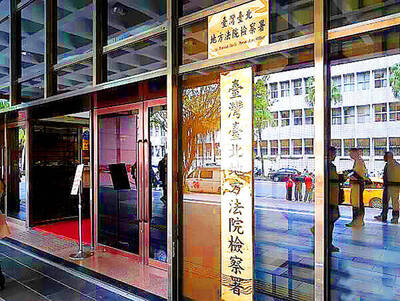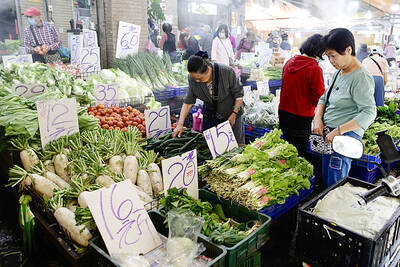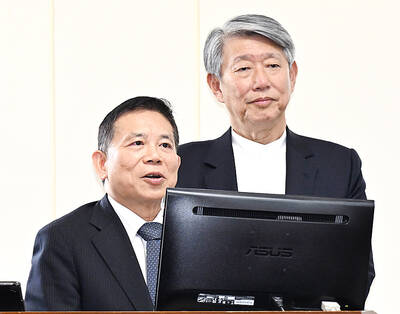Two British men who spent more than a year retracing the rugged route of the 1930s "Long March" by Mao Zedong's (毛澤東) communist guerrillas said yesterday it turned out to be about one-third shorter than reported by Communist Party propaganda.
Ed Jocelyn and Andy McEwan said their findings showed the trek -- a major event in the formative years of the party that took power in 1949 -- to be some 6,000km.
History books often say the Long March covered 10,000km. Some say it was as long as 13,000km.
"Some will get upset at what they see as an attack on a central myth of the revolution. The Long March is the founding myth of the party," McEwan said by mobile telephone from near Yanan, where Mao's forces settled in western China following the march.
Jocelyn, 35, and McEwan, 37, said they had worked in Beijing as editors for English-language publications by the city government. Their background is not in geography or history.
Between 1934 and 1935, fleeing the forces of Chinese Nationalist Party leader Chiang Kai-shek (蔣介石), Mao and his Red Army followers walked through some of China's poorest, most remote areas, from Jiangxi Province in the southeast to Shanxi in the north.
Jocelyn and McEwan completed their journey on Monday. They based their estimate of its length on timed walks, maps and distance markers along the way.
McEwan said the men were "astonished" by the relative freedom the enjoyed during the trek. Many of the areas they passed through were closed to outsiders after the 1949 revolution.
However, he said the pair were detained four times by suspicious local authorities, and once held overnight and bused out of the area the next day. Hardships also included sickness, dog bites and harsh weather.
But McEwan said people along the way were welcoming and excited about the project, often correcting their route and pointing out trails taken by the communists.
Jocelyn said the pair hope to exhibit photographs and other documentation collected during their trip, in part to remind younger generations of Chinese of their history.
"It was still a remarkable achievement in endurance and courage. The fact that it's shorter than originally believed doesn't diminish that in any way," Jocelyn said.
The pair also said they met a woman during their 384-day walk who they claimed might have been a long-lost daughter of Mao, the communist founder who died in 1976.
The woman, 68-year-old Xiong Huazhi, was born at about the same time and place as a daughter reportedly born to Mao and his third wife, He Zizhen, McEwan said.
Mao's child was left with a family in Sichuan Province as the Red Army fled attacks by Chiang. Xiong's family and neighbors told Jocelyn and McEwan that she was Mao's daughter, although no genetic link or other hard evidence has been provided.

Intelligence agents have recorded 510,000 instances of “controversial information” being spread online by the Chinese Communist Party (CCP) so far this year, the National Security Bureau (NSB) said in a report yesterday, as it warned of artificial intelligence (AI) being employed to generate destabilizing misinformation. The bureau submitted a written report to the Legislative Yuan in preparation for National Security Bureau Director-General Tsai Ming-yen’s (蔡明彥) appearance before the Foreign Affairs and National Defense Committee today. The CCP has been using cognitive warfare to divide Taiwanese society by commenting on controversial issues such as Taiwan Semiconductor Manufacturing Co’s (TSMC, 台積電) investments in the

INVESTIGATION: The case is the latest instance of a DPP figure being implicated in an espionage network accused of allegedly leaking information to Chinese intelligence Democratic Progressive Party (DPP) member Ho Jen-chieh (何仁傑) was detained and held incommunicado yesterday on suspicion of spying for China during his tenure as assistant to then-minister of foreign affairs Joseph Wu (吳釗燮). The Taipei District Prosecutors’ Office said Ho was implicated during its investigation into alleged spying activities by former Presidential Office consultant Wu Shang-yu (吳尚雨). Prosecutors said there is reason to believe Ho breached the National Security Act (國家安全法) by leaking classified Ministry of Foreign Affairs information to Chinese intelligence. Following interrogation, prosecutors petitioned the Taipei District Court to detain Ho, citing concerns over potential collusion or tampering of evidence. The

‘COMPREHENSIVE PLAN’: Lin Chia-lung said that the government was ready to talk about a variety of issues, including investment in and purchases from the US The National Stabilization Fund (NSF) yesterday announced that it would step in to staunch stock market losses for the ninth time in the nation’s history. An NSF board meeting, originally scheduled for Monday next week, was moved to yesterday after stocks plummeted in the wake of US President Donald Trump’s announcement of 32 percent tariffs on Taiwan on Wednesday last week. Board members voted to support the stock market with the NT$500 billion (US$15.15 billion) fund, with injections of funds to begin as soon as today. The NSF in 2000 injected NT$120 billion to stabilize stocks, the most ever. The lowest amount it

NEGOTIATIONS: Taiwan has good relations with Washington and the outlook for the negotiations looks promising, Minister of Economic Affairs J.W. Kuo said Taiwan’s GDP growth this year is expected to decrease by 0.43 to 1.61 percentage points due to the effects of US tariffs, National Development Council (NDC) Minister Paul Liu (劉鏡清) said at a meeting of the legislature’s Economics Committee in Taipei yesterday, citing a preliminary estimate by a private research institution. Taiwan’s economy would be significantly affected by the 32 percent “reciprocal” tariffs slapped by the US, which took effect yesterday, Liu said, adding that GDP growth could fall below 3 percent and potentially even dip below 2 percent to 1.53 percent this year. The council has commissioned another institution